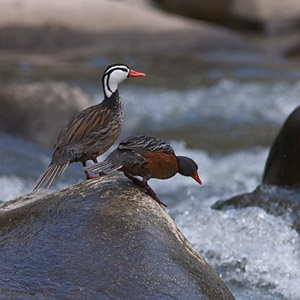Magazine | Analyses
Rencontre avec la Merganette des torrents le long du rio Urubamba (Pérou)

Couple de Merganettes des torrents (Merganetta armata), rio Urubamba (Pérou), juillet 2013.Photographie : Marc Fasol
Introduction
La Merganette des torrents (Merganetta armata) est un beau canard vivant le long des cours d’eau au débit rapide le long de la cordillère des Andes, du nord-ouest du Venezuela à la Terre de Feu au Chili, principalement entre 1 500 et 3 000 mètres d’altitude. Quatre autres espèces d’Anatidés dans le monde vivent dans un habitat similaire : l’Arlequin plongeur (Histrionicus histrionicus) dans l’Arctique, le Canard de Salvadori (Anas waigiuensis) en Nouvelle-Guinée, le Canard noirâtre (Anas sparsa) en Afrique australe et l’Hyménolaime bleu (Hymenolaimus malacorhynchos) en Nouvelle-Zélande.
La merganette se nourrit principalement d’invertébrés qu’elle recherche sous l’eau, entre les rochers, en plongeant la tête et le cou tout en nageant, le corps penché vers l’avant. Elle est aussi capable de nager sous la surface à contre-courant et vole au ras de l’eau sur de courtes distances si elle est dérangée. Son mode de vie rappelle ainsi celui du Cincle plongeur (Cinclus cinclus).
Outre un habitat plutôt particulier pour un canard, cette espèce est originale à plus d’un titre : sa parade est complexe et ritualisée, la fréquence de sa voix lui permet de communiquer malgré le bruit de fond des rapides, elle possède des éperons, sa queue est rigide et son organisme est adapté au manque d’oxygène.
Marc Fasol a pu l’observer et la photographier en juillet 2013 au Pérou le long du rio Urubamba, non loin des ruines de Machu Picchu.
Abstract
The Torrent Duck (Merganetta armata) is a beautiful duck living along the fast flowing rivers in the Cordillera of the Andes, from Venezuela to Chile, mainly between 5,000 and 10,000 feet. In the World, four other species of Anatidae live in a similar habitat: the Harlequin Duck (Histrionicus histrionicus) in the Arctic, the Salvadori Duck (Anas waigiuensis) in New Guinea, the African Black Duck (Anas sparsa) in Southern Africa and the Blue Duck (Hymenolaimus malacorhynchos) in New Zealand.
The Torrent Duck feeds mainly on invertebrates that it searches underwater between rocks, plunging head and neck while swimming with the body leaning forward. It is also able to swim under the surface against the tide and flies just over the water for short distances when it is disturbed. Its ecology is thus quite similar to that of the Dipper (Cinclus cinclus).
In addition to its special habitat, this species is unique in many ways: its parade is complex and ritualized, the frequency of its voice allows him to communicate despite the noise of the rapids, it has spurs and a stiff tail and its body is adapted to the lack of oxygen.
Marc Fasol watched and photographed this species in July 2013 in Peru along the Urubamba River, not far from the ruins of Machu Picchu.
Poursuivez la lecture de cet article, en vous abonnant dès maintenant !
Découvrez les Archives d’Ornithomedia.com
Pour seulement 10,00 €TTC/an (ou 6,00 € les 6 mois)
Profitez de plusieurs centaines d’articles en accès illimité et sans aucun engagement.
Compléments
Auteur
Marc Fasol : marc.fasol@icloud.com
À lire aussi sur Ornithomedia.com
- À la recherche des colibris endémiques du Pérou
- Description d’une nouvelle espèce d’oiseau au Pérou, le Mérulaxe de Junín ou de Getty
- Trajet ornithologique sur la route de Satipo (Pérou) du 16 au 27 novembre 2005
- Deux secteurs intéressants le long de la route du Manú
À lire sur le web
Le site web Peru Birding Routes : http://www.perubirdingroutes.com
Ouvrages recommandés
- The Birds of Ecuador: Field Guide de Robert S. Ridgely
- Birds of Peru de Thomas S. Schulenberg, Douglas F. Stotz, Daniel F. Lane et John P. O’Neill
- A Field Guide to the Birds of Brazil de Ber van Perlo
- Birds of Peru MP3 Sound Collection de Peter Boesman (2009)
- Carte Nationale Pérou – N°763 – échelle 1/1500000 de Collectif Michelin
Sources
- Jan Eldridge (1979). Display inventory of the Torrent Duck. Wildfowl (30). Pages 5 -15. http://wildfowl.wwt.org.uk/index.php/wildfowl/article/download/597/597
- José Luis Venero Gonzales (2010). Comportamiento de Merganetta armata (Gould, 1842) en el Río Vilcanota (Aguas Calientes[Machu Picchu] Cusco – Perú). Boletin UNOP. http://guzlop-editoras.com/web_des/bio01/zoo/pld0718.pdf
- Wilner Daniela (2013). Dealing with hypobaric hypoxia in the Andes: Genotypic Adaptation and Phenotypic Plasticity in the Torrent Duck (Merganetta armata Gould 1842). UAF. https://scholarworks.alaska.edu/handle/11122/1997?show=full
- Gerardo Cerón et Claudia Boy (2014). Prey Selection and Energy Values of Main Food Items of the Torrent Duck (Merganetta armata) in Northwestern Patagonia, Argentina. Waterbirds 37(2). Pages : 153-161. www.bioone.org/doi/abs/10.1675/063.037.0204
- Milton W Weller . Plumages and wing spurs of torrent ducks Merganetta armata. WWT. http://wildfowl.wwt.org.uk/index.php/wildfowl/article/view/332





Aucun commentaire sur ce sujet
Participer à la discussion !